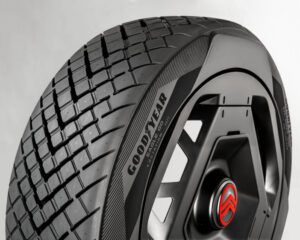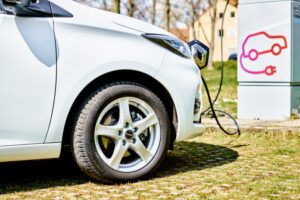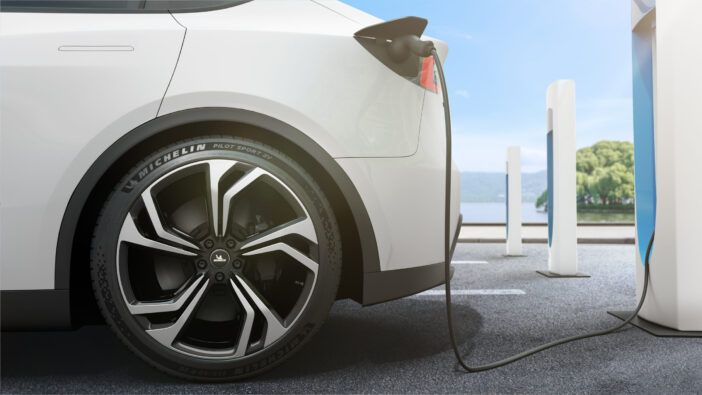Words Helen Norman
In August 2022 French tire manufacturer Michelin announced that after eight years it was withdrawing from the ABB FIA Formula E World Championship. Michelin was a founding partner of the world’s first all-electric single-seater racing series and an investor from its outset in 2013.
The firm’s involvement in Formula E, according to Cyrille Roget, group technical and scientific communication director at Michelin, has enabled it to accelerate its development of tires specifically for EVs – both on the racetrack and off, giving it a head start in the electric vehicle tire market.
“This is the reason we wanted to be involved in Formula E in the first place,” Roget says. “We wanted to develop racing tires, which were closer in design and performance to the ones you can find on the roads. Our goal was to develop one unique tire which could be used on dry and wet surfaces and on different track temperatures.”
That unique tire was the Pilot Sport EV, which like road tires featured a patterned tread when it was revealed along with Formula E’s first all-electric single-seater. Throughout its eight years in Formula E, Michelin worked hard to improve the energy efficiency, rolling resistance and weight of that tire to make it more environmentally friendly.
In the 2018/2019 Formula E season, for example, Michelin’s engineers focused on improving the third-generation Pilot Sport EV’s mass. With each tire tipping the scales as much as 2.5kg less than the former version, the total weight saving amounted to practically 10kg per set of four, the equivalent of a single front tire. This improvement was not only significant because it meant less weight needed to be transported to and from races, but also because it resulted in fewer raw materials having to be recycled.
It also meant extended range. At the 2019 Marrakech E-Prix, the cars were a whole three seconds a lap faster than they had been in comparable conditions at the previous season’s visit to Morocco. Michelin will now hand over the Formula E tire baton to South Korean tire firm Hankook.
“Some of the technology we developed for Formula E and the Pilot Sport EV racing tire is now in use in our road tires,” says Roget. One of those tires is the Pilot Sport EV for electric sports cars, which was launched mid-2021. The tire incorporates Michelin’s ElectricGrip Compound technology, which features a hard compound for the center of the tread to provide the grip required to cope with the high torque characteristics of electric sports cars. Meanwhile, the sidewalls carry over the same pattern and velvet-finish markings of Michelin’s Formula E tire. The Pilot Sport EV comes in a choice of 16 sizes for 18-22in rims.
“We have also developed the e.Primacy, which is for mid-sized to large EVs,” explains Roget. “This vehicle has been developed to help EV owners extend range and reduce impact on the environment as it is very durable.”
According to Michelin, ePrimacy features an airtight Energy AirShield Compound, which reduces energy dissipation while the CoolRunning Sidewall absorbs less energy during flexion. Thanks to these developments battery range can be increased on average by 7% – about 30 additional kilometers for a 400km estimated range. Furthermore, the tire’s MaxTouch Construction maximizes road contact, evenly distributing the forces of acceleration, braking and cornering to deliver longer tread life without sacrificing performance.
Sustainable tires
Michelin may have withdrawn from Formula E, but it continues to see motorsport as a way to accelerate EV tire development, with a particular focus on increasing the use of sustainable materials. Over the past two seasons, it has increased the average proportion of sustainable materials that go into the production of its tires for motorcycle racing’s FIM MotoE World Cup to 40%.
Meanwhile, Michelin is working on the MissionH24 project, which is paving the way for hydrogen fuel-cell electric prototypes to compete in the Le Mans 24 from 2025. A new tire for the program containing 53% bio sourced/recycled raw materials was recently revealed. By 2050, Michelin’s aim is to manufacture all the tires it makes using sustainable materials alone, with an interim target of 40% by 2030. “We also have an ambition to reach 100% sustainable material rate in our tires by 2050,” Roget adds.
To further help it achieve this target, in October 2022, in a world-first, Michelin unveiled two tires – one for use on cars and the other for buses – containing 45% and 58% of sustainable materials respectively. Approved for road use, these tires have performance levels exactly in line with Michelin’s conventional tires. Michelin owes this progress to the increased use of natural rubber, together with the inclusion of recycled carbon black, oils such as sunflower oil and bio-sourced resins, silica from rice husks and even recycled steel in its tires.
“These technologies will be on the market in 2025,” says Roget. “They are ready now, but we are currently missing the industrial process to develop them at scale.”

EV tire demands
Michelin is continually working on improving its EV-specific tires to help OEMs extend battery range and reduce energy consumption. “EVs put new demands on the tires,” Roget explains. “The vehicle is heavier because of the battery – and this is only set to increase as consumers demand more range. The battery can add on average about 250kg of additional weight. As the vehicle is heavier, the brakes need to be larger, leading to bigger rims and bigger tires. This means EV tires need to be more durable as the wear rate is faster.
“Noise is another consideration,” Roget continues. “As there is no engine noise anymore, what you hear inside the vehicle are the tires. We have developed a technology called Acoustic, which is a foam inside the tire helping to reduce the level of noise inside the vehicle. Depending on the OEM, this tech can reduce noise by about 9dB.”
Michelin is also currently working with the European Commission on a regulation to limit particle emissions from tires, which could enter force in 2026. “This will outline the minimum performance a tire has to meet before it can be put on the market in Europe,” Roget explains. “This would help eliminate the tires, which are the worst performing in terms of emissions on the market today.”
Pirelli Elect
Another tire manufacturer active in developing tire technology specifically for EVs is Pirelli. Earlier this year the firm announced that it had doubled the total number of tire approvals on electric and plug-in hybrid cars in 2021. This follows the launch of its EV-specific Elect solution in 2019, which is a package of technologies integrated into the tire that enables driving comfort, along with contained road noise, immediate grip, a long range (thanks to a reduced level of rolling resistance) and safety.
In 2021 alone, the number of Elect homologations exceeded 250. “This number highlights Pirelli as the tire manufacturer with the biggest share of homologations for electric and plug-in hybrid cars,” explains Pierangelo Misani, executive vice president of R&D and cyber at Pirelli.
Elect marked tires have several features that make them specific to the needs of electrified cars. They are quieter in order not to compromise the low noise produced by electric engines; they enhance battery life and lower emissions thanks to reduced rolling resistance; and they also have a structure and tread compounds that support high amounts of torque and heavy weight, due to batteries.
Like Michelin, Pirelli is also focused on improving the sustainability of its tires. “Pirelli is paying ever-greater attention to the environmental impact of its products, including through the introduction of sustainable materials into tires. This is true not only for tires with Elect technology, but also for the whole range,” adds Misani.
Pirelli has introduced its own ‘eco safety design’ approach, which involves the design and manufacture of tires that guarantee lower environmental impacts while ensuring greater driving safety. Attention to the reduction of environmental impacts is central to every phase of product development: from the choice of raw materials to production, as well as logistics, tire performance, and the management of the end of life of the product.
“Some of the innovative materials that Pirelli R&D is working on are already in use in the composition of current tires, added to the natural or synthetic rubber that forms the basis of the tire. For example, rice husk: a waste product from the food industry, which is a more sustainable alternative to the quartz sand normally used to produce silica; or lignin – present in all plants – which is the second most common natural polymer and can be obtained from wood processing waste in paper production, replacing the fossil products commonly used,” adds Misani.

Meeting the requirements of EVs
Unlike Pirelli and Michelin, Continental does not have any EV specific tire lines, but it is increasingly developing tires that meet the specific requirements of e-vehicles. In fact, in 2021, seven of the 10 highest-volume manufacturers of EVs worldwide relied on its technological expertise for their original equipment, including Tesla, Porsche and Mercedes-Benz. “Many years ago, we began to gear our tire development work even more rigorously toward reducing vehicle emissions, with the aim of meeting the requirements of electric mobility as effectively as possible,” explains Andreas Schlenke, benchmarking, portfolio and pre-tire development, Continental.
“This development focus is now bearing fruit for us, as when it comes to tires the same maxim applies to highly efficient EVs and low-emission combustion-engine vehicles: lower energy consumption equates to greater sustainability – regardless of the type of drive system. In a combustion-engine vehicle this results in lower emissions, in an EV through a longer range. That is why virtually all our products have been designed to help all vehicles run efficiently – irrespective of the type of drive system.”
One area of focus for Continental for meeting the requirements of electric mobility is developing tires that can handle the increased weight of EVs. “Most electric cars are around a third heavier than combustion-engine equivalents,” says Schlenke. “For instance, a VW ID.3 has a curb weight of approximately 1.8 metric tons – which is quite high compared with other models of its size. The reason for this is its still very heavy battery. This kind of vehicle must be fitted with tires that have been designed to handle the higher loads involved and developed for this usage scenario.
“To meet this need, Continental is manufacturing the first passenger tire with the new ‘HL’ load index code. Inflated to the same pressure, this tire has a higher load capacity than those built to the former XL standard. The load capacity of this HL tire stands at 825kg (load index 101), which equates to a 10% increase over the familiar XL standard of 750kg (load index 98),” Schlenke adds.
“In addition, an electric drive system develops its torque differently to a combustion engine. When an electric car pulls away, its tires must transfer all the torque produced by its drive system to the road instantly. The increased loads and higher torque generated by an EV can increase tire wear. Continental was quick to respond to these technical challenges at the product development stage. The EcoContact 6, for example, has a wear-resistant polymer compound and a tread design which can withstand the higher drive forces generated by electric cars,” Schlenke concludes.

